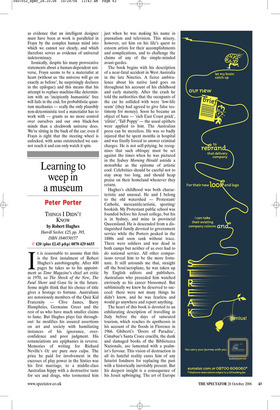Learning to weep in a museum
Peter Porter
THINGS I DIDN’T KNOW by Robert Hughes Harvill Secker, £25, pp. 395, ISBN 1846550157 ✆ £20 (plus £2.45 p&p) 0870 429 6655 It is reasonable to assume that this is the first instalment of Robert Hughes’s autobiography. After 400 pages he takes us to his appointment as Time Magazine’s chief art critic in 1970, so The Shock of the New, The Fatal Shore and Goya lie in the future. Some might think that his choice of title gives a hostage to fortune. Australians are notoriously members of the Quiz Kid Fraternity — Clive James, Barry Humphries, Germaine Greer and the rest of us who have much smaller claims to fame. But Hughes plays fair throughout: he modifies his assured assertions on art and society with humiliating instances of his ignorance, overconfidence and poor judgment. His renunciations are epiphanies in reverse. Memories of writing for Richard Neville’s Oz are pure mea culpa. The price he paid for involvement in the excesses of play power in the Sixties was his first marriage, to a middle-class Australian hippy with a destructive taste for sex and drugs, who tormented him just when he was making his name in journalism and television. This misery, however, set him on his life’s quest to esteem artists for their accomplishments and complications, and to challenge the claims of any of the simple-minded avant-gardes.
The book begins with his description of a near-fatal accident in West Australia in the late Nineties. A fierce ambivalence about his native land goes on throughout his account of his childhood and early maturity. After the crash he told the authorities that the occupants of the car he collided with were ‘low-life scum’ (they had agreed to give false testimony for money). Soon he became an object of hate — ‘rich East Coast prick’, ‘elitist’, ‘Tall Poppy’ — the usual epithets were applied to him. The Australian press can be merciless. He was so badly injured that he spent months in hospital and was finally forced to answer criminal charges. He is not self-pitying; he recognises that such obloquy must be set against the times when he was pictured in the Sydney Morning Herald astride a motorbike as the epitome of artistic cool. Celebrities should be careful not to stay away too long, and should heap praise on their homeland whenever they return.
Hughes’s childhood was both characteristic and unusual. He and I belong to the old watershed — Protestant/ Catholic, mercantile/artistic, sporting/ bookish. My Protestant public school was founded before his Jesuit college, but his is in Sydney, and mine in provincial Queensland. He is descended from a distinguished family devoted to government service while the Porters peaked in the 1880s and soon sank without trace. There were soldiers and war dead in both camps but neither of us ever had to do national service. All other comparisons reveal him to be the more fortunate. It still astounds me that, straight off the boat/aeroplane, he was taken up by English editors and publishers. Australians who preceded him watched enviously as his career blossomed. But subliminally we knew he deserved to succeed: there were not many things he didn’t know, and he was fearless and would go anywhere and report anything.
The heart of this book is devoted to an exhilarating description of travelling in Italy before the days of saturated tourism, which reaches its apotheosis in his account of the floods in Florence in 1966. Ghiberti’s ‘Doors of Paradise’, Cimabue’s Santa Croce crucifix, the dank and damaged books of the Bibliotecca Nazionale, are lamented with a psalmist’s fervour. This vision of destruction in all its hateful reality cures him of any futurist fondness for replacing the past with a historically inevitably present. But his deepest insight is a consequence of his Jesuit upbringing. The art of Europe is predominantly Christian in iconography, and finally Hughes was forced to admit to himself that the doctrinal assertions he grew up with were not true that one prays ‘through’ the image to the transcendent reality beyond. He came to believe that there is no such transcendence: only the icon counts and is real.
‘You should,’ he writes, ‘learn to weep in a museum.’ He does so, standing in front of Duccio’s ‘Maesta’ in Siena, quoting Yeats to himself. His next volume of autobiography should show him weeping while he writes the books he produced when working for Time-Life, an extraordinary predominance of seriousness over expedience.
His autobiography is clearly intended for the American market, and not just in its spelling. There is much explaining of terms familiar to British and Australian readers. And how did certain things escape those American enforcers, the fact-checkers? Australia’s immigration minister was Calwell, not Caldwell; Dr Crippen was British, not American; and Monsieur Jourdain was appalled, not delighted, to discover that he had been speaking prose all his life. Art needs good friends who are not just ‘village explainers’, even when the village is New York. Hughes is one such and he remains a sure guide through the ‘selva oscura’ of modern painting.



























































































 Previous page
Previous page